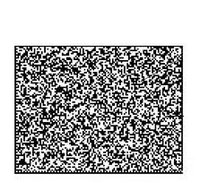A couple weeks ago, I was interviewed by the Wall Street Journal about how the camera on a mobile phone and barcodes will provide a way to surf the physcial world. The camera acts like a mouse and barcodes will provide hyperlinks to a website.
Jessica had read The Pondering Primate and asked for my input.
A lot of the interview wasn't included, but the idea that
the WSJ is exposing this disruptive technology, is very encouraging.
Cellphone Services Read Codes On Ads, Products, Buildings And Link to Details OnlineWhile shopping at a Whole Foods store in Los Angeles, Richard Jefferson spotted a curious sticker with tiny black squares on a package of Yum Tum raw vegan pizza.

Intrigued, he sent a text message to a number listed on the package and received a link prompting him to download software to his Sony Ericsson cellphone to decipher what turned out to be a bar code.
The software allowed him to snap a picture of the bar code to be connected to a Web page with recipes and health tips from Yum Tum, a raw-foods brand in Los Angeles.
These are codes from Netxcode's Connexto.
"This could be huge," he says. A rising number of people are using new free services to connect to the mobile Internet by photographing bar codes. The codes -- either conventional bar codes or digital ones -- are showing up on more products, advertisements, books and even buildings.
I have been calling them physical world hyperlinks . The camera on the mobile phone acts as a mouse and the barcode is used as a hyperlink to get to a targeted website.
The technology is popular in Asia but previously failed to catch on in the U.S. after several attempts. Now, improving technologies and the ubiquity of camera phones are triggering
a host of new bar-code services. Nokia Corp. has built its
own bar-code reader into new models of two camera phones that are scheduled to become available in the U.S. this fall.

Scanbuy Inc.'s.
Scanbuy Shopper, expected to be live in the next few weeks, grabs Shopping.com prices and reviews, for example, from a Universal Product Code, or UPC.
Nextcode Corp. has launched
ConnexTo , mobile software for reading digital bar codes that are cropping up on food packaging and posters.
NeoMedia Technologies Inc., which owns mobile-ad firms, will launch its bar-code reader
PaperClick later this year.

The codes are appearing gradually in grocery stores, embedded in business cards, on promotional posters and T-shirts and even near landmarks like the Chrysler Building, around where people placed a code linking to the building's Wikipedia entry.
They are piquing the interest of advertisers who see the potential to serve up more relevant ads -- a trailer downloaded off a movie billboard, for instance -- and consumer-product companies trying to make products more interactive.
The technology, part of the mobile industry's push to embed more functions and features into mobile devices, is still in its early stages, meaning the
new services may only work with some camera phone models and service providers. While there is vast potential for the technology -- from downloading movies off billboards to helping diabetics purchase food safe for them to eat -- a range of hurdles have some questioning whether the applications are functional enough to succeed.
Not all software programs can read all types of bar codes. This means consumers must, for now, pick and choose among services.
Scanbuy, for instance, works with standard bar codes while
Semacode Corp . uses a code standard called
Data Matrix. When PaperClick launches it is likely to used a third symbology,
Aztec .
The new services also have some competition from other companies working to provide similar services off existing logos and images, not bar codes.
Mobot Inc., owned by PaperClick's parent company NeoMedia, lets users snap images directly from a magazine or billboard.
The user sends the picture to an address, and Mobot's technology reads the contours of the image stored in its database and sends a message back with the relevant content, such as promotion details.Packages of Yum Tum's raw food
use a new-style bar code that links customers to recipes and ingredient information.
Companies are seeking to
make the bar-code technology easier to use by preloading it on mobile devices. Consumers, who are turning to their phones for a multitude of functions from downloading ringtones to text messaging to mobile Web browsing, also appear more ready for the services, which are free excluding data fees.
About 15% of U.S. cellphone users accessed the Web on their phone last month, according to Seattle-based mobile-research firm
M:Metrics.While two Nokia models will come with bar-code readers standard in a few months, consumers for now have to get the software themselves.
Most services can be downloaded to a camera phone by typing a Web address into the device's browser. Some applications, such as PaperClick, ask those who sign up for some demographic information such as age and location to better tailor the types of results they see.

From there, users click on the application icon, hold the camera a few inches away from the code, and click as if taking a photo. (
Some detect the code automatically and register it without clicking.) The software decodes the information, typically a Web link, and quickly directs the user to the relevant Web page.
It's a new chapter in bar-code history. In the 1950s, two inventors filed the first bar-code patent, which included a sketch of a ring of concentric circles. In later decades the Universal Product Code, a symbol whose fine lines could be scanned at a checkout counter, for instance, emerged.
Today, commercial uses of bar codes proliferate. Airlines use them to shuttle around baggage and delivery services rely on them to help track packages. The Pondering Primate, Scott Shaffer, 39 years old, a private investor in Boca Raton, Fla., recently went to the ConnexTo Web site to create his own bar code that he now puts on his business cards. Now, anyone with the ConnexTo reader downloaded to their phone can snap one of his cards to be routed to a Web site with his name, address, phone number and email.
Google Inc. and Yahoo Inc. already offer mobile versions of shopping Web sites or text-messaging services that pull up a few lines of abbreviated text per query.
Scanbuy Shopper promises to deliver more information like reviews and comparison statistics through miniature Web pages. The new service, which will
allow users without the appropriate camera phone or lens to key in the bar-code number manually, has also been updated to read codes in dim light and at odd angles.
Textbook publisher Prentice Hall will be putting PaperClick smart codes in the next edition of one of its introductory-marketing textbooks expected to be released in January 2007. A handful of codes will appear in some entries in the text linking to further examples and related news articles.
Nonprofit groups also are using bar codes for new purposes. A world-wide project called
Semapedia involves people creating more than 2,500 codes that they are sticking to or near landmarks like the Leaning Tower of Pisa or Machu Pichu. The codes link to the Wikipedia entry for the location.
Write to
email Jessica E. Vascellaro










